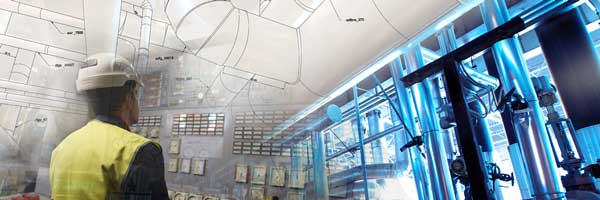
Lately, there has been a major emphasis on new technology that helps automate supply chain processes while improving transparency. A critical area where supply chain automation technology is gaining ground is in the warehouse.
In fact, a recent study by Zebra Technologies reveals that 6 in 10 companies are planning to augment labor with more warehouse automation by 2024.
When it comes time to determine if a new warehouse automation technology is worth the cost, you turn to return on investment or ROI. Essentially, ROI is determined by weighing the solution’s value creation and savings against the technology’s overall cost.
But what factors should you take into account when considering the ROI of warehouse automation systems?
Critical value-adds that make up the potential ROI for a new warehouse automation solution may be hiding under your nose. Many factors are often overlooked because they are “hidden” in areas you may not suspect.
In this article, we are going to touch on several of these “invisible” value-adds that influence the ROI of warehouse automation software.
DOWNLOAD:Key ROI Criteria for Warehouse Automation (free white paper download) »
Finding ROI in Your Line-level Workforce

Your workers are the muscle that drives daily operations in the warehouse, on the manufacturing floor, the yard, and every area where supply chain processes can be found. Even though these hardworking teams are handling the bulk of line-level activities, how their activities affect the bottom line is easy to miss.
Part of this comes from an outdated mode of thinking, in which labor is a machine that comes with immovable barriers in productivity, speed, and cost. This is not so. Rather than viewing labor as an inevitable expenditure, look at labor as an opportunity to add value to your business.
Warehouse automation technologies like mobile data collection solutions with barcode scanning is a great example. Equipping your workforce with mobile barcode scanners running software with validated integration to your ERP and other business systems can enable employees to operate at the point of work, collecting data with near 100% accuracy and communicating that high-quality information to your ERP database.
LEARN MORE: Why Inventory Accuracy Matters »
Without expanding the size of your team or pumping additional resources into infrastructure upgrades, mobile barcoding can fuel faster, more efficient work at higher accuracy and with greater flexibility.
In addition, mobility is intuitive and easy to learn, shortening training periods for new users. Workers using mobility can reach full productivity in less time, adding more value to your business.
According to the white paper, Value Creation for Warehouse Automation Technologies, mobile technologies like voice picking and mobile barcoding can reduce onboarding and training times by 77% or more. For employees that require 13 weeks to become fully trained to 100% productivity, a 77% reduction cuts this time to just 15 workdays. For operations that rely on seasonal workforces, this gain could represent a critical must-have.
Using mobile tech can also contribute to reducing turnover rates. According to the Human Capital Benchmarking Report study released by The Society for Human Resource Management (SHRM), the average cost of onboarding an employee is $4,129. Any positive impact on turnover and tenure becomes a value-add that boosts ROI.
The labor time saved, reduced inventory errors and higher volume capabilities not only helps your operation generate more revenue but passes that added value downstream to other areas of your enterprise, as well as your customers.
ALSO READ: Addressing Talent Acquisition in Supply Chain Management »

Creating Value with Priceless Visibility
Transparency in supply chain processes is a big push – and for good reason. Real-time visibility into inventory levels and movements can offer valuable insights into avoiding excess stock, optimizing working capital, preventing unexpected shortages and running a lean or agile operation.
For manufacturers, track-and-trace for ingredients, components, raw materials, and finished products are essential to staying in compliance with industry and federal regulations. Failure to adhere to regulatory restrictions can lead to devastating recalls, litigation, and brand damage that lasts for years.
In 2012, a single food recall of peanut butter produced by Sunland, Inc. cost the company nearly $1 billion.
Government contractors require documentation in order to achieve 100% billing accuracy, especially when it comes to weeding out counterfeit parts or dealing with government-owned inventory. Inability to provide appropriate records can lead to loss of invaluable contracts.
Implementing SCM software to create this live view of material movements can present significant cost savings in ways not always recognized. For example:
- Real-time tracking enables reduced levels of safety stock and carrying costs, freeing up resources for other projects.
- Live, accurate data eliminates much of the time workers waste looking for misplaced or phantom inventory that isn’t where it’s supposed be.
- Food traceability can make or break a food manufacturer’s business, helping to reduce the scope and impact of a recall by as much as 95%. Read More »
- The ability to locate, track and issue fixed assets and spare parts for MRO spread across multiple locations in your enterprise is crucial to maximizing uptime and avoiding safety issues.
And these are only a handful of the ways warehouse and supply chain automation solutions can generate ROI for your business.
A Right Fit: Don’t Bite Off More Than You Can Chew

The impact of warehouse automation on your operation is an all-too-often neglected factor in determining ROI. In short, seeking out the biggest, most powerful automation solution may not be in your best interest. Not only will you pay more out of pocket up front, but you will also end up sinking massive amounts of time, resources, and work hours into implementing, supporting and later developing that solution as your business grows.
Take the time to determine the functionality you actually need and what solution will be the best fit for your organization. For example, that best-of-breed WMS software may offer all the shiny bells and whistles you could want, but how long will it take before it’s up and running? 12 months? 24 months? 30? Will it consume so many resources to implement that it will impact your regular day-to-day operations until go live? What will be the cost of building out new functionalities in the future after that?
In the end, the complexity, cost, and length of implementation could grind your regular operation to a halt and vastly increase the chance of a failed implementation altogether.
Instead of using a heavyweight WMS to gain live inventory insights, you could use a simpler, more flexible automation technology like mobile data collection with barcoding software. Using mobile wireless handheld barcode scanners with mobile inventory management software, your warehouse gains the same core WMS capabilities. A mobile ecosystem also integrates and communicates bi-directionally with your business systems, databases, ERPs, MES and more. Such mobile barcoding technology can be implemented in a shorter time, provide innumerable cost benefits and generate a more reasonable ROI (without the headaches).
The money you save from not “over-buying” can then be invested in other valuable initiatives, such as infrastructure upgrades, growth, or expanding the functionality of your new digital automation tech.
LEARN MORE: WMS Lite: Gain Essential Best-of-Breed Functionality at a Fraction of the Cost »
…And Don’t Forget the Indirect Cost Savings
Research tends to leave out the indirect or intangible cost benefits that create ROI for warehouse automation technology. These contributors to ROI are more difficult to nail down but have very real, if not large, impacts. Therefore, it’s vital to align with other divisions, departments and stakeholders in your organization to articulate these factors.
Some indirect cost savings you should consider:
- How much does each data error cost your business?
- How much does the negative impact of that error affect your brand’s reputation?
- How do you quantify the dollar value of growth possible after implementing the new solution?
- How much does each workplace injury cost your business using manual processes?
- How much will you save by adopting an all-in-one solution that includes built-in mobile app development?
- How many development hours (and at what hourly rate) will you save by having a mobile app development platform (MADP) that your in-house team can use?
- What is the cost of a lost contract due to lack of track-and-trace technology?
- How much money does your enterprise save by increasing efficiency, accuracy and productivity for line-level workers at each facility?
- What emergency fund will be required to account for unexpected costs in implementing this solution? Is it less or more than other solutions?
ALSO READ: Addressing Talent Acquisition in Supply Chain Management »
Learn More About ROI Criteria for Digital Warehouse Automation
If you are interested in learning more about how to calculate ROI for potential digital warehouse automation solutions, be sure to download a free copy of the white paper: Key ROI Criteria for Warehouse Automation: Cost-saving factors to consider when evaluating new warehouse automation technology. Or schedule your very own personalized ROI workshop.






